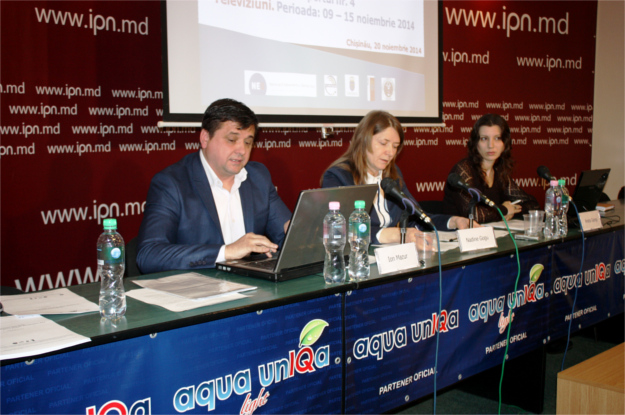
Ion Mazur, program coordinator of the Association of Independent Press (AIP), mentioned that the most of the materials providing direct or indirect coverage of the electoral campaign appeared in newspapers Nezavisimaya Moldova (19), Timpul and Komsomolskaya Pravda v Moldove (17 each), and the least – in Vesti Gagauzii (5). Compared with previous monitoring periods, print media offered less space for electoral education.
The expert also said that more than half of the materials published by the eight monitored newspapers were biased, presenting events through the prism of authors, whose position could be easily perceived by readers. The newspapers that stood out in this regard were Nezavisimaya Moldova (with 18 biased articles out of total 19), Jurnal de Chișinău (10 out of 13), Timpul (11 out of 17) and Moldova Suverană (8 out of 14).
Speaking about the coverage of the electoral campaign by online portals, Nadine Gogu, director of the Independent Journalism Center (IJC), underlined that they had been very active and published over 500 materials during the monitoring period. The portals that stood out are Realitatea.md (69 materials), Noi.md and Omg.md (62 materials each), and Jurnal.md (60 materials). According to the speaker, news with a conflicting nature were mostly presented in an unbalanced manner, citing a single source, and the gravest situation had been found on omg.md, where all 16 conflicting materials were based on a single source. Politik.md and Moldova.org acted similarly.
Nadine Gogu also found that the monitored online portals mainly involved officials and politicians as sources, while the share of experts and ordinary citizens was insignificant. Out of the ten monitored portals, Noi.md covered the most electoral contestants, while Moldova.org – the least. About 24% of the materials covering the campaign and electoral contestants were biased, making the journalists’ positions towards protagonists of materials obvious.
Nadine Gogu also informed that the monitored radios broadcast a small number of conflicting materials, and that most of them were balanced.
Like online portals, the majority on radio stations involved officials and politicians as sources. Exceptions were Vocea Basarabiei and Radio Moldova, which used a wider variety of sources.
Radio Moldova, Russkoe Radio and Radio Noroc stood out by broadcasting a large number of materials of electoral education and advertisements of electoral contestants. According to the report, the three broadcasters showed no tendencies of clearly favoring or disfavoring an electoral contestant, while Radio Plai favored the Democratic Party of Moldova (PDM) by mentioning it in a large number of news items, and Vocea Basarabiei favored the Liberal Democratic Party of Moldova (PLDM) by the large number of direct interventions and by mentioning representatives of this party and of the Government in a positive context.
Radio Moldova and Vocea Basarabiei ensured access to a large number of electoral contestants to newscasts and debates, while Russkoe Radio, Radio Noroc and Radio Plai offered airtime to a limited number of electoral contestants.
The coverage of the electoral campaign by the 12 monitored televisions did not change greatly compared with previous periods. According to Aneta Gonta, APEL expert, during the week of 9 to 15 November “no tendency of balanced and fair television coverage of all electoral contestants was observed.” Televisions admitted evident imbalance in the number of electoral contestants’ appearances in newscasts. Thus, PDM was favored by a large number of appearances in a positive context on Prime TV, Publika TV, Canal 2 and Canal 3. The PLDM was especially favored on N4 and TV7, while the Party of Socialists of the Republic of Moldova (PSRM) – on Accent TV.
Jurnal TV disfavored the PDM by means of a large number of appearances in a negative context, while Accent TV disfavored the PDM and the PLDM.
The electoral contestants that enjoyed the greatest visibility through electoral advertizing were the PLDM and the PDM, and the smallest – the People’s Party of the Republic of Moldova (PPRM).
One third of all news items on electoral topics had a conflicting nature. 64% of such materials abided by professional ethics, and 36% neglected them. Jurnal TV, Pro TV Chișinău and Moldova 1 came the closest to the rules for the production of news items (two or more sources were cited), while Accent TV and N4 did not always follow this rule, added Aneta Gonta.
The monitoring of mass media in the electoral campaign for parliamentary elections is conducted as part of the project financed by the National Endowment for Democracy, the US Embassy in Moldova and the East Europe Foundation. The following monitoring report will be presented next week.










